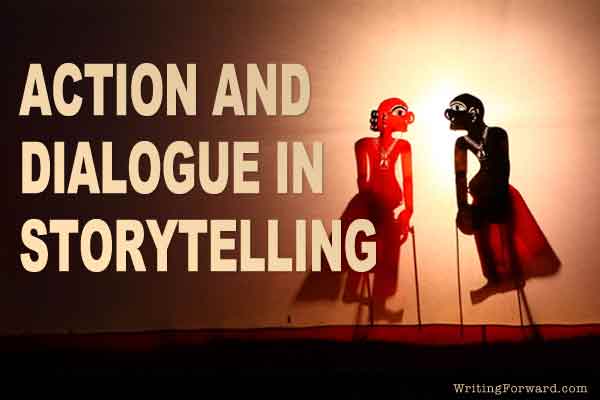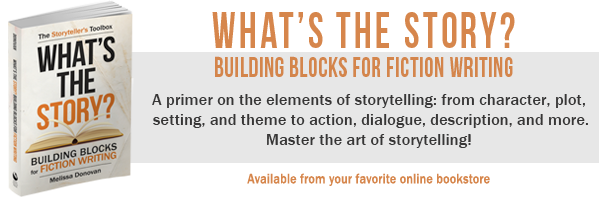Today’s post is an excerpt from What’s the Story? Building Blocks for Fiction Writing, chapter seven: “Action and Dialogue.” Enjoy!
Action and dialogue are the wheels that carry a story forward. The easiest way to imagine action and dialogue in written narrative is to think of a movie. When characters onscreen do things, that’s action. When they talk, that’s dialogue. Most of a story’s momentum is contained in action and dialogue.
You may have heard the old writing adage, “show, don’t tell.” It’s one of those sayings that becomes blatantly obvious once you get it. Readers want to see what’s happening. Characters walk and talk. They kick and punch and scratch. They cry and laugh, run and hide. They do things and say things. That’s how story happens: through action and dialogue.
Action
Action can be contained within a single word: chase. It can be an entire scene that shows a character being chased down streets, through buildings, and then trapped in a corner. It can be threaded through dialogue as characters are talking to one another while they are being chased.
But action isn’t always high octane. Action is an effective way to add realism to a story, such as when characters eat and drink while having a conversation. This type of action is most effective when it’s carefully crafted to move the story forward in the best way possible.
Everything that characters do, from guzzling a beer to engaging in an epic battle, is action. Consider a scene where two characters are eating at a restaurant, having a conversation that is vital to the story. As they chat, they check out the other diners, look at their food, taste their food, and have a drink. All these actions can be used to take us deeper into the characters and the story. Is one character checking out the other diners, looking for someone they know? Are they worried they’re being followed? Does a character eye the food with disgust or hunger? What food do they order? Are they drinking water or wine? Juice or beer? These choices will give the readers insight into the characters’ personalities.
Action often intensifies as the story approaches the climax. The stakes get higher, things speed up. There are fewer casual chats in restaurants. Instead, there are heated arguments and fights, and all emotions are ratcheted up several notches. All of this is depicted through action that moves a little faster and is explained in language that adequately conveys not only what is happening but also how it’s happening, and perhaps most importantly, how it feels.
Dialogue
Excellent dialogue can send a story soaring to new heights. Dialogue is an expression of the characters that reveals their personalities. Because character is where readers forge emotional connections with stories, well-crafted dialogue can deepen a reader’s involvement with the characters, and by extension, the story.
Consider the following famous lines of dialogue from films and you’ll begin to understand the power of dialogue:
“I’ve got a bad feeling about this.” (Star Wars, 1977)
“Go ahead, make my day.” (Sudden Impact, 1983)
“I’ll have what she’s having.” (When Harry Met Sally, 1989)
Even if you haven’t seen any of these movies, there’s a good chance you’re familiar with these quotes. When characters make witty quips and snazzy one-liners, they pop off the page and make the character and the moment memorable, sometimes to the point that a line of dialogue becomes embedded in our culture.
Dialogue can also boost characterization by making characters distinct through the way they talk. Characters from one country will have different expressions and language patterns than characters from another country. These patterns occur at more local levels as well. People from different regions—states, provinces, and cities—will use unique expressions and language patterns. If one character is from Texas and another is from California, they’re going to speak differently from each other. Ensuring that these differences come though in a story’s dialogue strengthens its realism.
But such patterns are also observable at the individual level. Maybe all your friends use the same language and speech patterns. But you probably know a few people who have distinct ways of speaking. Most of us have certain words that we often use or particular ways of stringing words together that differ slightly from our friends and family. Maybe you know someone who says dude a lot or who pauses at unusual intervals. Dialogue that is styled in a way that is unique to each character can lend realism to the characters, and the more realistic the characters are, the more likely it is that audiences will attach to them.
Action and Dialogue Working Together
Action and dialogue serve a story best when they work together and are interspersed in a smooth way. Characters do things while they talk. They eat, they pace, they make faces and gestures, they use body language. And characters talk while they do things. They chat while eating, working, and traveling.
Although some stories are successful with long sequences of dialogue that don’t include much action, scenes tend to come alive better in readers’ minds when chatter is interspersed with action. But as with all elements of storytelling, both the action and the dialogue should be necessary to the story and should move it forward in meaningful ways.
Want to learn more about writing action and dialogue? Pick up a copy of What’s the Story? Building Blocks for Fiction Writing.






Always good reading your posts, full of good information for beginning writers. This one in particular, I think is especially good advice.
Thank you so much!